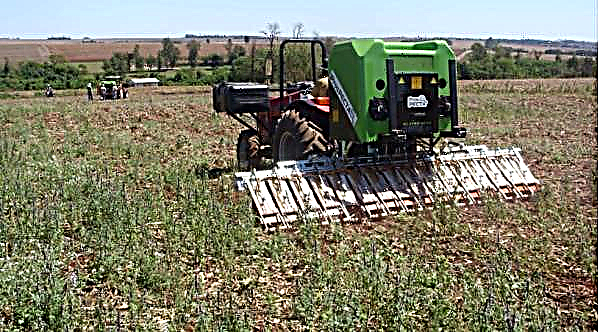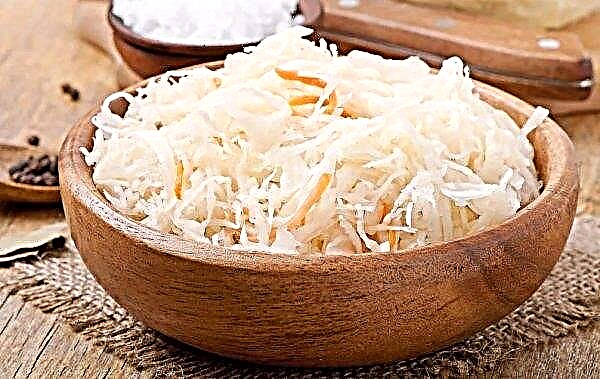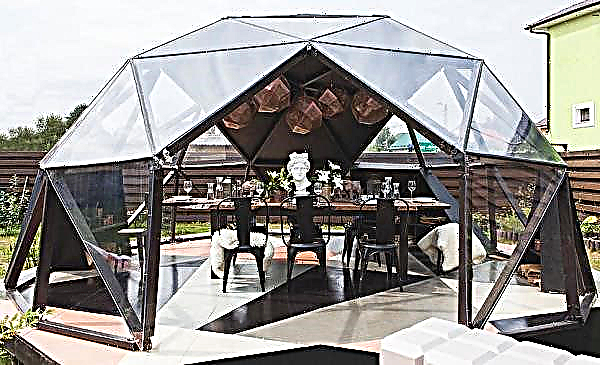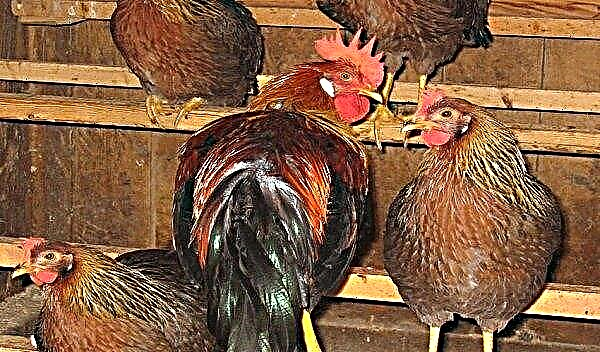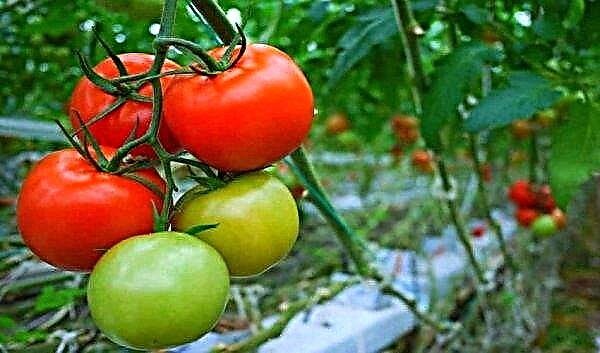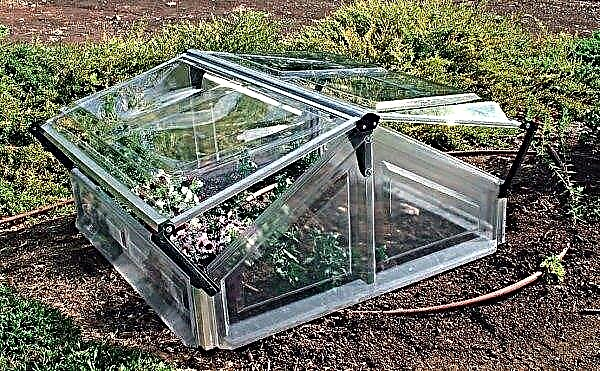The representative of the American selection of strawberries Monterey, despite her relative youth, has already managed to win the hearts of many domestic gardeners. It is characterized by a long fruiting period, excellent resistance to ailments and excellent quality of berries. We consider in the article what are the features of cultivation of the described variety and agrotechnical care for it.
Botanical grade description
Strawberry Monterey is a repair cultivar of the early growing season, which was obtained by genetic scientists from the state of California, USA, by crossing the large-fruited Albion variety with special selection number Cal 97.85-6. From its genetic basis, the new variety received high fruiting rates (35% better than the “parent”), as well as a more juicy and soft fruit structure.
Monterey bushes are powerful, strong, have a well-developed root system. On erect stems there are quite large, large leaves of the correct form, a bright green saturated color with a shiny smooth surface. During the flowering period, which falls in May, large peduncles of white color are formed on the bushes, in the amount of 10-14 units, which almost never have empty flowers.
Did you know? Strawberries in folk healing are used to eliminate headaches and migraines. The fact is that its composition contains substances close to the composition of traditional aspirin.
The fruits of Monterey are large, cone-shaped with a slight sharpening on the tip, dark red in color, with a shiny surface. The weight of strawberries, depending on the wave of the crop, is 30–35 g at the first harvest and 40–50 g at the second harvest. The pulp is characterized by a dense, but at the same time tender structure, high juice content, pleasant strawberry aroma. The taste of berries is sweet, very delicate.
Characteristics of berries and bush
In recent years, the Monterey variety has gained wide demand for cultivation both by private gardeners and for industrial purposes. Such popularity is due to the excellent characteristics of the culture.
Features of fruiting
Monterey belongs to the category of repair crops in which fruiting for the season occurs in several stages. As a rule, during the growing season, 3-4 crops can be harvested from one bush, and, starting from the second fruiting, the quality of the fruits improves significantly - they become more sugar, juicy and tender. Reviews gardeners say that the culture shows excellent productivity.
Important! Crop yields can drop at very high air temperatures, above +30°C. Under these conditions, the berries ripen, but do not have time to gain weight.
Subject to the basic rules of agricultural technology and favorable climate conditions, from one plant you can collect from 500 to 2000 g of berries. Harvest ripens in waves. Feather fruits are ready for harvest already in early June. The last time strawberries are harvested in late October. In a greenhouse, the described variety is able to bear fruit year-round, however, for this it needs to organize a comfortable microclimate and adequate lighting.
Consumer qualities of berries
Monterey berries have excellent taste and presentation. Thanks to the dense structure, they perfectly tolerate transportation even over long distances, are well preserved, do not change their taste and shape after freezing. Strawberries are widely used in the culinary field for the preparation of desserts, sauces, and pastries. It is perfect for whole-canned preserves and preparations for the winter, for the preparation of jams, preserves, sweets. The berries make excellent fruit drinks, compotes, juices, alcoholic and non-alcoholic drinks.
Strawberries are widely used in the culinary field for the preparation of desserts, sauces, and pastries. It is perfect for whole-canned preserves and preparations for the winter, for the preparation of jams, preserves, sweets. The berries make excellent fruit drinks, compotes, juices, alcoholic and non-alcoholic drinks.
Sustainability
The commercial variety Monterey is characterized by excellent immunity, which is able to protect the plant from the most common ailments, such as late blight, verticillin wilt, anthracnose. Compared to other varieties, it is rarely exposed to leaf brown spots, but in some cases it may suffer from powdery mildew.
Winter hardiness of the crop is average, therefore, without proper shelter for the winter, the plant can seriously suffer. The described strawberries are recommended for cultivation in regions with moderate climatic conditions - in Ukraine, Belarus, and the middle zone of the Russian Federation.
Advantages and disadvantages, differences from other varieties
- Strawberry Monterey fell in love with domestic gardeners due to the large number of positive qualities, among which are noted:
- early fruiting, as well as fruiting in 3-4 waves throughout the season;
- high yields;
- excellent marketable and flavoring properties of fruits;
- berry keeping and excellent transportability;
- preservation of the shape and taste of fruits when they are frozen;
- strong immunity to many fungal diseases;
- a small number of antennae, which greatly simplifies the care of the plant;
- palatability, density and juiciness of strawberries do not depend on weather conditions;
- can be used both for home growing and for industrial.
- When cultivating the culture of the described variety, some of its disadvantages should be taken into account:
- the need for large space for growing bushes;
- reduction in yield at high air temperatures;
- poor immunity to powdery mildew;
- low winter hardiness, the need for shelter for the winter;
- frequent planting renewal - ideally, bushes should be rejuvenated every two years.

Landing Features
Since Monterey is characterized by a high intensity of growth of bushes, when planting a plant, it is necessary to provide a lot of free space. At the same time, landing work must be performed, observing several important rules.
Recommended Dates
Strawberries can be planted in spring, summer or autumn. In spring, the last week of May is considered the best period for planting, when the soil warms up well and the risk of night frosts completely disappears. In the summer, the most favorable time for planting seedlings is considered to be the end of July - the first weeks of August.
When autumn planting is necessary to propagate the culture until the end of September. If planting was carried out in the spring, then the first fruits can be obtained in the same year. When planting at another time, fruiting will begin next season. Propagation of strawberries with a mustache.
Propagation of strawberries with a mustache.
Choosing the right place
As already noted, strawberries prefer fairly spacious, free from other vegetation, smooth, without slopes and depressions sections. Preference should also be given to well-lit, sunny, protected from winds and drafts, beds, with a groundwater table of at least 2 m. If the groundwater level is high enough, then it is recommended to plant the crop on a small hill.
Monterey perfectly grows and bears fruit on nutritious, light and loose soils with a neutral level of acidity. The plant will not bear fruit on swampy, clay or too acidic soils. The best option is moderate chernozem with a small sand content.
Did you know? It is very useful to eat strawberries for people suffering from nervous disorders. Its composition has all the vitamins of group B, which soothe the nervous system, relieve depression, it is enough to eat 150 g of fruits to neutralize negative emotions.
Preparing planting material
To bookmark a strawberry plantation, you should choose high-quality and healthy material. For this, strong and large bushes with fully developed root roots are selected. Patients who have sagged, curved seedlings with insufficiently developed, rotted or weakened root systems are rejected. Saplings that have open root processes are planted immediately. If this is not possible, then the plant is instilled in moistened peat so that the shoots do not frown. Before planting seedlings in open soil, the root system is soaked for several hours in any growth activator and treated with special preparations against fungi.
Saplings that have open root processes are planted immediately. If this is not possible, then the plant is instilled in moistened peat so that the shoots do not frown. Before planting seedlings in open soil, the root system is soaked for several hours in any growth activator and treated with special preparations against fungi.
Landing algorithm
A few weeks before planting, the area under the strawberries must be carefully dug up, cleaned of weeds and vegetation, enriched with humus soil with the addition of superphosphate and potassium salts.
Important! For planting, experts advise choosing cloudy days. When planting in sunny weather, the plantation must be shaded for a few days.
The sequence of planting seedlings is as follows:
- dig holes with an interval of 35-40 cm, row spacing - about 50 cm;
- 300 ml of not cold defended water are poured to the bottom of the recess;
- A seedling is put into a pit, root processes are gently straightened;
- sprinkle seedlings with soil so that the growth point remains on the surface;
- the earth is slightly tamped, watered abundantly;
- after the moisture is completely absorbed, the soil is covered with a layer of mulch from straw, sawdust or peat.

Subsequent Strawberry Care
The fruiting and quality of strawberries after planting will depend on the timeliness and literacy of agricultural practices to care for it.
It should be noted that the care of the culture is traditional and includes such procedures:
- Watering. Monterey, like her "parent" Albion, is a moisture-loving plant that needs abundant and regular hydration. In dry and hot weather, the bushes are watered daily, using 20-30 liters of water per 1 m² of planting. The amount of moisture in the soil directly affects the taste of the fruit - the more moisture, the more juice in the berries. However, it is recommended to ensure that the soil has time to dry before the next watering.
- Top dressing. Active repeated fruiting during the season greatly depletes the culture, so it needs to be additionally fed with organic or munitions. The first portion of fertilizers is applied in early spring, using nitrophosphate in a proportion of 2 tbsp. l drug per 1 m² area. The second time the soil is fed in early June with a mullein solution. In the last weeks of July, strawberry plantations are fed a mixture of wood ash, superphosphate and nitrate, mixed in proportions of 5: 1: 1.

- Loosening the soil and weeding weeds. A mandatory step in the care of strawberries is loosening the soil, which allows you to enrich the earth with oxygen and valuable elements for the growth of the culture, and contribute to the development of the root system. Loosening is carried out systematically, after watering. It is equally important to monitor the cleanliness of the plantation, to destroy weeds that inhibit the growth of strawberries. Weeding the beds is carried out regularly, if necessary.
- Winter preparations. Since the plant has a low winter hardiness, it must be covered for the winter. To do this, still in the early autumn, loosen the soil to a depth of 5-6 cm, after the last harvest, the soil is mulched, in late autumn, the bed is covered with lapnik.
Important! When using agrofibre to shelter landings, it is recommended to lay it on metal arches or a wooden frame. The installation of fiber on the ground will contribute to freezing of the soil and, as a result, to freezing and decay of the roots.
Pest and disease protection
As noted, the Monterey variety has a strong immunity and is able to perfectly resist such ailments as late blight, verticillin wilt, brown spotting. However, under adverse climatic conditions, it is often affected by powdery mildew, which, in the absence of proper therapeutic measures, can provoke the death of the entire strawberry plantation. Powdery mildew on strawberries usually appears already in the first decade of May. To eliminate the ailment, they use special chemicals that spray the bushes after the complete destruction of the infected areas. Among pests, the plant is most often affected by a nematode. Effective methods of pest control are considered to be the treatment of the culture with broad-spectrum insecticides.
Powdery mildew on strawberries usually appears already in the first decade of May. To eliminate the ailment, they use special chemicals that spray the bushes after the complete destruction of the infected areas. Among pests, the plant is most often affected by a nematode. Effective methods of pest control are considered to be the treatment of the culture with broad-spectrum insecticides.
To prevent the occurrence of the parasite, folk remedies are used:
- before planting seedlings, I spray the soil with a concentrated salt solution - 5 liters of water, 5 tbsp. salts;
- in the spring, the bushes are sprayed with a 1% solution of Bordeaux fluid.
Did you know? The world's largest strawberry was grown in 1983 in the city of Rolkston, USA. The weight of the berry was 231 g, but its taste was far from ideal: it was watery and very acidic.
Effective preventive measures against parasites and ailments are:
- regular loosening and mulching of the soil;
- the destruction of weeds and vegetation in the garden;
- crop rotation compliance;
- preventive spraying of bushes.

Harvesting and storage
Monterey berries are harvested up to four times per season, starting in May and ending in October. The fruiting time of the culture is 10-14 days. Strawberries are removed as it ripens by hand, tearing along with the stalks. It is better to harvest in the morning or evening hours, because in sunny weather the berries lose their strength and become sluggish.
The collected berries are sorted, discarded, rotted, wrinkled and damaged. Dense ripened fruits are placed in wooden containers in several rows. Since strawberries have a fairly dense structure, while it does not lose its presentation, does not let the juice and does not deform. Keep the crop at a temperature of 0 ... + 5 ° C in the refrigerator for two weeks.
Strawberry Monterey, despite some moodiness in leaving, is great for experienced gardeners as well as for beginners. The variety stably bears fruit even in poor climatic conditions, is characterized by strong immunity, with the competent implementation of basic agricultural practices, it is able to please a worthy crop of juicy, healthy and aesthetically attractive berries.






